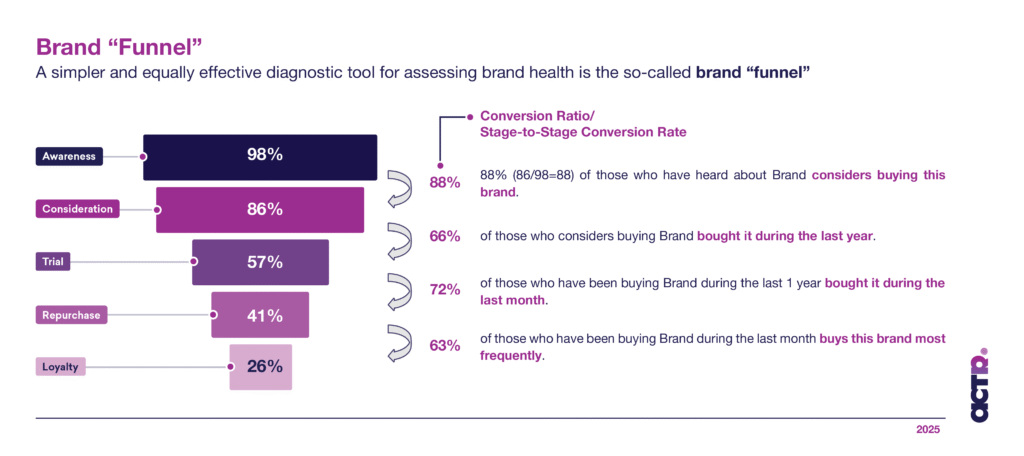How to measure Brand health?

How to measure Brand health?
Nuka Bilanishvili, ACTR
Portfolio Lead
It is no secret that people encounter health problems at different stages of their lives. Some of these problems are mild and can be resolved easily, while others require serious attention. The earlier the problem is identified, the faster and more cost-effectively it can be addressed. The same principle applies to brands, as they are, in essence, living organisms—just like people—with their own characteristics, identity, values, behaviors, and communication. Brands are created and shaped by people, both inside and outside the organization—through loyal and even non-loyal customers. Therefore, it is important for every company to constantly monitor the brand’s pulse through regular diagnostics, identifying the causes of hidden problems or visible pains and providing effective treatment.
The Importance of Diagnostics
Periodic diagnostics allow companies to monitor not only their own brand’s position but also the positions of competing brands, the effectiveness of marketing activities, and market trends. As a result, the company gains a comprehensive picture of market dynamics and the brand’s weak areas, which is a prerequisite for timely and effective decision-making.
Traditional Approach to Brand Health Assessment
The classic, academic approach to assessing brand health involves the examination of the following tasks:
- Determining brand awareness levels;
- Determining market share/consumption rates;
- Identifying image-related parameters perceived by customers, defining brand image and positioning;
- Identifying the leading purchase motivations and barriers for customers;
- Determining the factors contributing to customer satisfaction or dissatisfaction;
- Segmenting customers/creating the typical customer profile.
The above tasks represent a comprehensive and systematic evaluation of a brand’s position in the market, in relation to both customers and competitors.
Brand “Funnel”
A simpler and equally effective diagnostic tool for assessing brand health is the so-called brand “funnel.”

Levels of the Brand Funnel
- Awareness – This is the first stage of the customer-brand relationship, showing what portion of the consumer market has heard about the brand.
- Consideration – This shows how relevant the brand is to the consumer market representatives and how likely they are to consider purchasing the brand in the future.
- Trial – The customer makes a purchase (either once or several times in the past year).
- Repurchase – The customer has a connection with the brand, with a higher-than-average frequency of consumption.
- Loyalty – The customer is loyal to the brand, with a high frequency of use.
Where Do You Lose Your Customers in the Brand Funnel?
If brand awareness is almost 100%, it does not necessarily mean that the brand has a strong market position. If awareness is high but the conversion rate to the consideration stage is low, it indicates that the reasons why potential customers are not considering purchasing the brand need to be identified. Key reasons for this could include, for example, ineffective or mis-targeted communication campaigns, a poor or undeveloped brand image.
A low rate at the trial/purchase stage might be due to issues like distribution problems, poor product visibility in stores, unattractive packaging, or an inappropriate price.
A low conversion rate from general use to regular use suggests that the customer tried the product, but the brand failed to convert them into a regular user because it didn’t meet their expectations in terms of taste, quality, or price alignment.
If the conversion rate from regular use to loyalty is low, it indicates that something is missing for the customer, and the brand needs to reflect on what needs to be improved. Low loyalty may be caused by factors like a lack of emotional connection, brand passivity, a lack of personalized offers, reputational issues, a shortage of innovation and newness, or poor service quality and negative customer experience (CX).
What to Keep in Mind When Analyzing the Funnel
When analyzing the brand funnel, it is important to conduct an in-depth analysis of each level, not just individual stages. On one hand, to gain a complete picture of the brand’s position in the market, the conversion rates of individual stages are not enough. It is crucial to look at the conversion rate at each level of the funnel and identify the problematic zones that require more effort. On the other hand, it is important to remember that increasing and maintaining customer loyalty requires a systematic and comprehensive approach.
To truly understand the market, it’s essential to assess both the target brand and its competitors. Evaluating competitor brand health provides a clearer view of the competitive landscape and highlights where rivals are strongest. Without this insight, decisions risk being driven by assumptions rather than facts. With a complete picture, brands can make more informed strategic decisions and significantly improve their chances of success.